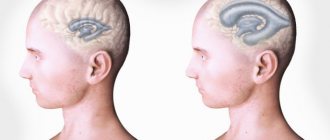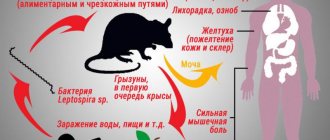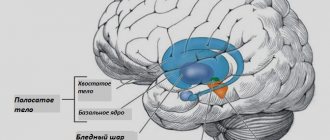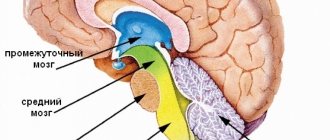Farah's disease was first diagnosed and described in the thirties of the 20th century. This disease is hereditary and is characterized by the manifestation of vascular calcification in the brain. Often this name is given to a group of pathologies that result in damage to areas and vessels of the brain. Calcium salts are deposited on the walls of small vessels and capillaries. Most often, Fahr syndrome manifests itself at the age of 40-50 years, but medicine knows cases of the disease occurring at an early age.
Neurodegenerative diseases
A group of similar diseases is characterized by manifestations of central nervous system lesions. A certain number of neurons die, which leads to the development of neurological pathologies. Neurodegenerative diseases can occur for a variety of reasons and also have different clinical manifestations. A characteristic feature of all diseases from this group is their incurability. All therapeutic actions performed are symptomatic.
That is, therapy is aimed at alleviating the symptoms of the disease, but in no way can affect the regeneration of areas that are damaged. The most effective treatment would be tissue transplantation, but this method has several limitations, primarily technical and moral.
Clinic and symptoms
Determining the presence of Farah's disease is complicated by an unclear clinical picture. The disease is often asymptomatic. Even if a person has been diagnosed with the development of the syndrome, he often does not feel it. Pathological accumulation of calcium in the brain area is manifested by the following symptoms:
When Fahr syndrome manifests itself with signs of parkinsonism, its symptoms may be:
- tremor;
- constant presence of muscles in a tense state;
- shuffling gait;
- a motionless face resembling a mask;
- involuntary clenching of fingers, simulating rolling of pills.
Such symptoms are characteristic of the late stage of the disease. In addition to the neurological and mental symptoms of the disease, signs of skull abnormalities, glaucoma, retinitis pigmentosa, and pathology of the endocrine system (hypoparathyroidism) are possible, although much less common.
Forms of the disorder - their symptoms
Common to any neurodegenerative disease is the slowly progressive death of nerve cells, but it can manifest itself in different forms and varieties.
The most common manifestation is parakinsonism, increased muscle rigidity. Dysfunction of the parathyroid gland, either primary or after surgery, alters the production of parathyroid hormone, which in turn increases the level of phosphorus in the blood and decreases the level of calcium.
Such disorders can manifest themselves in the form of tremor, dystonia, dyskinesia, involuntary spasms of the face, limbs or torso.
The next most common are disorders of the basic functions of the brain, which are manifested by weakening of memory, an excessively strong reaction to various events in a person’s life.
The connection of the disease with a disruption of normal calcium metabolism leads to neurological manifestations, accompanied by muscle spasms. The disease also manifests itself in psychiatric disorders, changes in approach, and severe pain.
Fahr syndrome is often diagnosed against the background of diseases such as toxoplasmosis, infection by the pork tapeworm parasite, and echinococcosis. Less commonly diagnosed is the disease expressed as tuberous sclerosis of Bourneville.
The most famous pathologies of this group
The most famous diseases of this group are Alzheimer's disease, Parkinson's disease, and Fahr's syndrome. Early diagnosis of these diseases is often difficult. In the diagnostic process, doctors mainly take into account patients' complaints and observe their behavior. The most modern and effective method for diagnosing diseases of this group is tomography, both computed tomography and magnetic resonance imaging.
Symptoms of the syndrome
Fahr's disease is very rare. That is why specialists are not able to draw up a correct clinical picture of the syndrome. Symptoms of the disease appear in patients over 40 years of age. In younger people, the symptoms of the syndrome are blurred and unclear. Patients suffer from poor motor coordination and develop parkinsonism. In addition, evidence of the development of the syndrome is the presence of tremor, dystonia, chorea (rapid and erratic movements of the limbs).
These are not all the symptoms of Farah disease.
The patient may also suffer from involuntary contractions of the feet and hands. Due to the fact that as a result of the disease, areas of the brain are damaged, the patient experiences a decrease in performance, mental abilities, and memory. Speech disturbances occur very often. Other neurological manifestations include the occurrence of pain and mental disorders.
Classification
In practical neurology, Farah's disease is divided into two clinical forms, differing in the age of manifestation and the type of predominant symptoms:
- Juvenile form - the onset of the disease occurs in childhood or adolescence. Extrapyramidal disorders in the form of athetosis, chorea, and muscular dystonia are characteristic. The pathology may be accompanied by oligophrenia. As people grow older, hyperkinesis changes to parkinsonian symptoms.
- Senile form - manifests in old and middle age. The clinical picture is characterized by the dominance of parkinsonian symptoms in combination with cognitive disorders. Progressive dementia is typical.
In practical neurology, Farah's disease is divided into two clinical forms, differing in the age of manifestation and the type of predominant symptoms:
- Juvenile form - the onset of the disease occurs in childhood or adolescence. Extrapyramidal disorders in the form of athetosis, chorea, and muscular dystonia are characteristic. The pathology may be accompanied by oligophrenia. As people grow older, hyperkinesis changes to parkinsonian symptoms.
- Senile form - manifests in old and middle age. The clinical picture is characterized by the dominance of parkinsonian symptoms in combination with cognitive disorders. Progressive dementia is typical.
Farah's disease: causes
Unfortunately, the exact reasons why the pathology arises and develops have not yet been established by doctors. But it is known that the greatest influence on the occurrence of such a disease is caused by disturbances in the functioning of the thyroid and parathyroid glands. As a result, a failure occurs in the metabolic process of phosphorus and calcium. Similar diseases of the neurodegenerative group can arise due to a violation of the acid-base balance in the body. Alkalosis causes a significant loss of acids, and alkaline compounds, in turn, are present in the body in excess.
Clinic and symptoms
Determining the presence of Farah's disease is complicated by an unclear clinical picture. The disease is often asymptomatic. Even if a person has been diagnosed with the development of the syndrome, he often does not feel it. Pathological accumulation of calcium in the brain area is manifested by the following symptoms:
- motor dysfunction;
- deterioration of mental activity, up to dementia;
- spastic paralysis;
- headache;
- disturbances in the movement of the eyeball;
- dysarthria;
- convulsive syndrome.
When Fahr syndrome manifests itself with signs of parkinsonism, its symptoms may be:
- tremor;
- constant presence of muscles in a tense state;
- shuffling gait;
- a motionless face resembling a mask;
- involuntary clenching of fingers, simulating rolling of pills.
Such symptoms are characteristic of the late stage of the disease. In addition to the neurological and mental symptoms of the disease, signs of skull abnormalities, glaucoma, retinitis pigmentosa, and pathology of the endocrine system (hypoparathyroidism) are possible, although much less common.
Forms of the disorder - their symptoms
Common to any neurodegenerative disease is the slowly progressive death of nerve cells, but it can manifest itself in
different forms and varieties.
The most common manifestation is parakinsonism, increased muscle rigidity. Dysfunction of the parathyroid gland, either primary or after surgery, alters the production of parathyroid hormone, which in turn increases the level of phosphorus in the blood and decreases the level of calcium.
Such disorders can manifest themselves in the form of tremor, dystonia, dyskinesia, involuntary spasms of the face, limbs or torso.
The next most common are disorders of the basic functions of the brain, which are manifested by weakening of memory, an excessively strong reaction to various events in a person’s life.
The connection of the disease with a disruption of normal calcium metabolism leads to neurological manifestations, accompanied by muscle spasms. The disease also manifests itself in psychiatric disorders, changes in approach, and severe pain.
Fahr syndrome is often diagnosed against the background of diseases such as toxoplasmosis, infection by the pork tapeworm parasite, and echinococcosis. Less commonly diagnosed is the disease expressed as tuberous sclerosis of Bourneville.
Diagnostic methods
Before the development of such a diagnostic method as computed tomography (CT), patients underwent X-rays of the brain. But thanks to the development of computer technology and progress in medical research, specialists are able to obtain images of the affected area with greater information content. It should be noted that for such a clinical picture, CT is more sensitive than MRI.
Analysis of most images suggests that the areas affected by Farah's disease (photo below) are limited to the globus pallidus.
Diagnostic measures
The primary diagnostic measure is examination and consultation with a neurologist. At the first suspicion of a disorder and to exclude similar diseases, a highly informative diagnostic method is prescribed - a computer scan. During screening, the presence of foci of accumulation of calcifications in intracerebral structures is revealed. An alternative method for examining the brain is magnetic resonance imaging, but when imaging tissue, calcium inclusions are less visible. But the accompanying atrophic processes appear better in the photographs.
The following are prescribed as additional parallel studies:
Laboratory analysis of blood solution for biochemistry. If natural blood electrolytes in the form of metal compounds remain relatively normal, this indicates the absence of disturbances in the body’s metabolism that affect the excessive accumulation of calcifications in the tissues.
- Study of hormonal blood balance. If no hormonal disturbances were identified as a result of a clinical examination, then there is no reason to believe that calcification is possible.
- Ultrasound examination of the glandular structure of the thyroid gland. Degenerative changes in this structure are not observed in patients with Farah anomaly, but with hormonal imbalance, other pathologies can be identified that are provoking or related factors in the development of the phenomenon.
- TCD of the vascular network of the head brain. The technique allows you to determine the dynamics of blood circulation in the organ. If ischemia develops, it is likely that calcification is the underlying cause.
- PCR. This technique allows you to find pathogenic elements that cause infection of the lining of the brain (bacteria, viruses, fungi). Chronic inflammation can lead to subsequent calcium deposition in the affected areas.
Fahr's disease: treatment
It is not possible to remove calcium deposits formed in the brain and its vessels. That is why treatment of the syndrome is symptomatic. Doctors focus all their efforts on eliminating the symptoms of the disease, and not the root causes of its occurrence. First of all, they try to improve the exchange of phosphorus and calcium in the patient’s body. If symptoms of a disease such as Parkinson's disease appear, the patient must be prescribed specific drugs (levodopa). In addition, the presence of Farah's disease and the process of treating the manifested symptoms involves taking antioxidants and other drugs that improve metabolism.
Therapy using calcium channel blockers is not effective.
In the vast majority of cases, treatment reduces symptoms, but does not in any way affect the degree of vascular calcification.
In Farah disease, symptoms and treatment are often interrelated.
Pathogenesis
The pathogenetic mechanisms that form the disease have not been fully determined. Genetically determined changes in cerebral metabolism are assumed, causing the deposition of excess calcium in the brain tissue. Severe calcification of subcortical formations causes disorganization of the frontal-subcortical system, which regulates voluntary movements and provides cognitive functions (memory, thinking, attention).
Morphologically, calcifications are found symmetrically in various structures: the cerebral cortex, white matter, subcortical ganglia, internal capsule, cerebellum, walls of small arteries, and less commonly veins. The presence of perivascular small calcium conglomerates is characteristic. The most massive calcification is detected in the subcortical regions.
The pathogenetic mechanisms that form the disease have not been fully determined. Genetically determined changes in cerebral metabolism are assumed, causing the deposition of excess calcium in the brain tissue. Severe calcification of subcortical formations causes disorganization of the frontal-subcortical system, which regulates voluntary movements and provides cognitive functions (memory, thinking, attention).
Morphologically, calcifications are found symmetrically in various structures: the cerebral cortex, white matter, subcortical ganglia, internal capsule, cerebellum, walls of small arteries, and less commonly veins. The presence of perivascular small calcium conglomerates is characteristic. The most massive calcification is detected in the subcortical regions. Microscopically, calcifications are distinguished by a typical structure, represented by threads 140-400 microns thick. They often contain mineral complexes with inclusions of iron, copper, aluminum, phosphorus, lead, zinc, and cobalt.
Inheritance of Fahr syndrome
This syndrome is a hereditary disease. Inheritance occurs according to an autosomal dominant pattern. What does this mean? This type of inheritance involves the transmission of dominant traits located in autosomes. Phenotypic manifestations can vary significantly. Such a sign can either manifest itself to a significant extent or be weakly expressed.
This type of inheritance has the following characteristic features:
- The trait will appear in every generation.
- The ratio of sick and healthy is one to one.
- If the future husband has Farah disease and a healthy child is born, then his children will also be healthy.
- The disease can affect girls and boys equally.
- The disease can be transmitted equally from both men and women.
- If both parents have the disease, then a child born homozygous for an inherited trait will be more seriously ill than a child born heterozygous.
- The more a trait affects reproductive function, the greater the likelihood that various mutations will appear.
Consequences
What are the consequences of Farah disease?
All of the listed characteristics are realized only if there is complete dominance, and for the appearance of the trait, only one gene of a dominant nature will be sufficient.
Based on the listed features of the type of inheritance through which Farah syndrome is transmitted, we can say that the presence of a diseased gene in the future father can cause the disease to manifest itself in the child. In order to determine the likelihood with which your child may inherit Farah disease, you should contact a genetics specialist who will conduct all the necessary studies and calculations and give a fairly accurate result.
Establishing diagnosis
Depending on whether Farah disease has symptoms, making a diagnosis can be somewhat more difficult. It is often diagnosed accidentally, when a tomography is performed to confirm a completely different disease. First of all, the specialist excludes calcium metabolism disorders and other developmental defects. Then a computed tomography scan (or x-ray examination) is prescribed. Doctors note that one of the problems in making a correct diagnosis is hypoparathyroidism. This is a disease that occurs due to parathyroid hormone deficiency. As a result, the level of calcium in the blood decreases, and the level of phosphorus increases. If calcification of the striopallidodentate structures is observed on a CT scan, then additional tests are necessary to distinguish hypoparathyroidism from a condition such as Fahr's disease. First of all, it is important to determine the level of parathyroid hormone and calcium. Also, when making a diagnosis, parasitic damage to the nervous system is used. Specific reactions occur in the blood and cerebrospinal fluid. Fahr's disease is rarely differentiated from a condition such as Bourneville's sclerosis.
Forecast
It must be borne in mind that the disease is quite rare and is currently not well studied, so the prognosis for the disease is very ambiguous. The accumulation of calcium and the increase in the number of deposits occurs very slowly, taking years or even decades. In addition, at an early stage the disease is practically not detected, and the size of the affected areas contradicts external signs. There is not enough information, it is impossible to determine the specifics of treatment. Thanks to early diagnosis methods, irreversible consequences can be eliminated.











